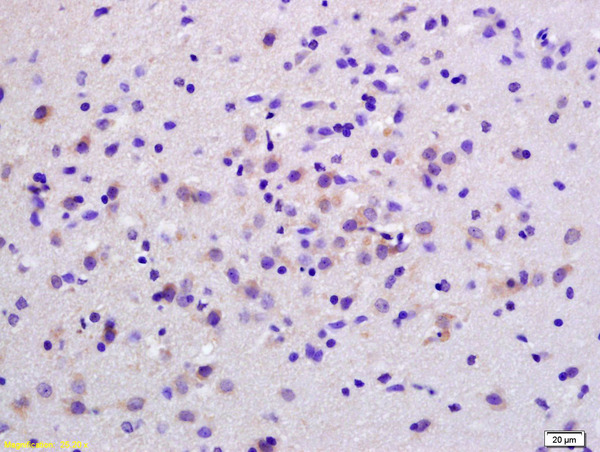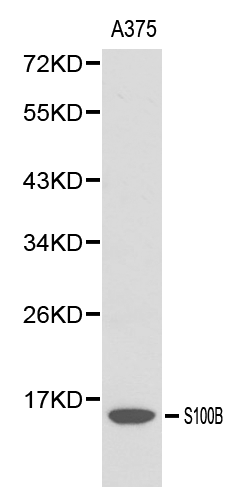![S100B(S100B/1012), CF594 conjugate, 0.1mg/mL [26628-22-8] S100B(S100B/1012), CF594 conjugate, 0.1mg/mL [26628-22-8]](https://biotium.com/wp-content/uploads/2018/10/BNUB1012.jpeg)
S100B(S100B/1012), CF594 conjugate, 0.1mg/mL [26628-22-8]
BNC941012
ApplicationsImmunoFluorescence, ImmunoHistoChemistry, ImmunoHistoChemistry Paraffin
Product group Antibodies
ReactivityBovine, Human, Mouse, Rat
TargetS100B
Overview
- SupplierBiotium
- Product NameS100B(S100B/1012), CF594 conjugate, 0.1mg/mL [26628-22-8]
- Delivery Days Customer9
- ApplicationsImmunoFluorescence, ImmunoHistoChemistry, ImmunoHistoChemistry Paraffin
- CertificationResearch Use Only
- ClonalityMonoclonal
- Clone IDS100B/1012
- Concentration0.1 mg/ml
- ConjugateOther Conjugate
- Gene ID6285
- Target nameS100B
- Target descriptionS100 calcium binding protein B
- Target synonymsNEF, S100, S100-B, S100beta, protein S100-B, S-100 calcium-binding protein, beta chain, S-100 protein subunit beta, S100 calcium-binding protein, beta (neural)
- HostMouse
- IsotypeIgG2a
- Protein IDP04271
- Protein NameProtein S100-B
- Scientific DescriptionS100 belongs to the family of calcium binding proteins. S100A and S100B proteins are two members of the S100 family. S100A is composed of an alpha and a beta chain whereas S100B is composed of two beta chains. This antibody is specific against an epitope located on the beta-chain (i.e. in S-100A and S-100B) but not on the alpha-chain of S-100 (i.e. in S-100A and S100A0). This antibody can be used to localize S-100A and S-100B in various tissue sections. S-100 protein has been found in normal melanocytes, Langerhans cells, histiocytes, chondrocytes, lipocytes, skeletal and cardiac muscle, Schwann cells, epithelial and myoepithelial cells of the breast, salivary and sweat glands, as well as in glial cells. Neoplasms derived from these cells also express S-100 protein, albeit non-uniformly. A large number of well-differentiated tumors of the salivary gland, adipose and cartilaginous tissue, and Schwann cell-derived tumors express S-100 protein. Almost all malignant melanomas and cases of histiocytosis X are positive for S-100 protein. Primary antibodies are available purified, or with a selection of fluorescent CF® Dyes and other labels. CF® Dyes offer exceptional brightness and photostability. Note: Conjugates of blue fluorescent dyes like CF®405S and CF®405M are not recommended for detecting low abundance targets, because blue dyes have lower fluorescence and can give higher non-specific background than other dye colors.
- SourceAnimal
- ReactivityBovine, Human, Mouse, Rat
- Storage Instruction2°C to 8°C
- UNSPSC12352203

![S100B(S100B/1012), CF594 conjugate, 0.1mg/mL [26628-22-8] S100B(S100B/1012), CF594 conjugate, 0.1mg/mL [26628-22-8]](https://biotium.com/wp-content/uploads/2018/10/BNUB1012-1.jpeg)
![S100B(S100B/1012), CF594 conjugate, 0.1mg/mL [26628-22-8] S100B(S100B/1012), CF594 conjugate, 0.1mg/mL [26628-22-8]](https://biotium.com/wp-content/uploads/2018/10/BNUB1012-2.jpeg)
![S100B(S100B/1012), CF594 conjugate, 0.1mg/mL [26628-22-8] S100B(S100B/1012), CF594 conjugate, 0.1mg/mL [26628-22-8]](https://biotium.com/wp-content/uploads/2018/10/BNUB1012-3.jpeg)
![S100B(S100B/1012), CF594 conjugate, 0.1mg/mL [26628-22-8] S100B(S100B/1012), CF594 conjugate, 0.1mg/mL [26628-22-8]](https://biotium.com/wp-content/uploads/2018/10/BNUB1012-4.jpeg)
![S100B(S100B/1012), CF594 conjugate, 0.1mg/mL [26628-22-8] S100B(S100B/1012), CF594 conjugate, 0.1mg/mL [26628-22-8]](https://biotium.com/wp-content/uploads/2018/10/BNUB1012-5.jpeg)





